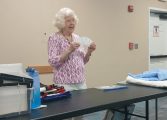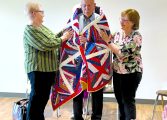By Page H. Gifford
Correspondent
Mary Volin recently moved to the area from Maine and was looking for artists like herself. She joined the Fluvanna Art Association and now that COVID appears to be manageable, she is looking forward to getting more involved with the group and the artistic community.
“It has been fun to connect with a new group of local artists and be inspired by a new landscape,” Volin said. She said she comes from a family of artists on her father’s side but remembers her grandfather telling her at a young age that there were easier ways to make a living. Therefore, she chose not to pursue art in college though her underlying passion told her this is what she wanted. While staying at home and raising her children, she took classes for fun and was encouraged to pursue art more seriously.
“I took a deep breath and in my mid-thirties went back to school for a BFA,” she said. “I wanted to paint, but needed to put back the money I raided from my kids’ college fund, so I pursued a major in graphic design and a minor in photography. I ended up working professionally as an art director and creative director for collectible and social expression companies in Maine.”
When Volin retired, she wanted to have fun with art and do something hands-on, but she wasn’t sure what that was. About 15 years ago, her mother-in-law invited her to paint a scarf with her at her retirement community.
“The minute I watched that paint flow on the silk, I was hooked,” she said. “Silk painting has been described as “watercolor on steroids.” Not only has she worked on silk but she has worked on cotton as well. “You don’t exactly work on fabric, you work with it.”
She says there are so many techniques for achieving different goals. Among her favorite techniques is Serti. Originating in Thailand, Vietnam, and India, it is an age-old technique for preventing color from bleeding by using resist lines. It uses dyes instead of fabric paint. Once the pattern is drawn, silk is laid over it, and resist lines – known as gutta – are applied to preserve the white space in the design.
She has also explored various Shibori sophisticated tie-dye techniques, hand printing, and vat dyeing. Originating in China, it was adopted by the Japanese. Labor-intensive in the preparation before dying, it calls for a variety of ways to create patterns by folding, pleating, tying, or sewing.
“There is no end to things to explore and I love to experiment,” she said. Volin’s work is vibrant and bright with bold patterns and colors and is a complement to any outfit.
In Maine, Volin belonged to a marketing co-op where she sold her scarfs, pillows, table runners, and fabric wall art. One of her pieces was published in Art Quilts International, Abstract & Geometric by Martha Sielman.
“Currently I hope to focus more on wall art while continuing to make the scarfs and decorative items I love.” Some of her work will soon be available at Sweet Art Emporium.




